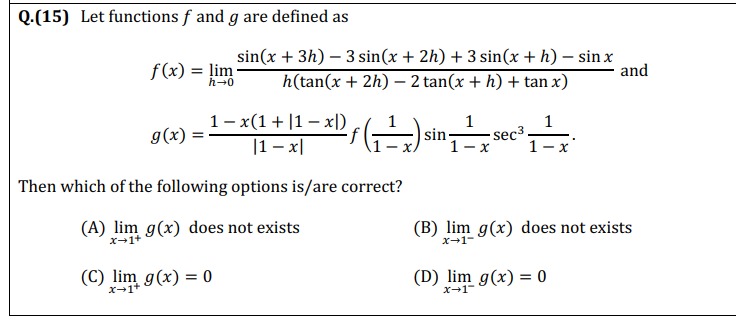Question
Question: Let functions $f$ and $g$ are defined as $f(x) = \lim_{h\to0} \frac{\sin(x+3h)-3\sin(x+2h)+3\sin(x+...
Let functions f and g are defined as
f(x)=limh→0h(tan(x+2h)−2tan(x+h)+tanx)sin(x+3h)−3sin(x+2h)+3sin(x+h)−sinx and
g(x)=∣1−x∣1−x(1+∣1−x∣)f(1−x1)sin1−x1sec31−x1.
Then which of the following options is/are correct?

limx→1+g(x) does not exists
limx→1−g(x) does not exists
limx→1+g(x)=0
limx→1−g(x)=0
(A), (D)
Solution
The function f(x) is given by f(x)=limh→0h(tan(x+2h)−2tan(x+h)+tanx)sin(x+3h)−3sin(x+2h)+3sin(x+h)−sinx.
The numerator is the third forward difference of sinx with step size h, evaluated at x. Using the Taylor series expansion of sin(x+kh) around h=0, sin(x+kh)=sinx+khcosx−2(kh)2sinx−6(kh)3cosx+O(h4).
Numerator = (sinx+3hcosx−29h2sinx−627h3cosx)−3(sinx+2hcosx−24h2sinx−68h3cosx)+3(sinx+hcosx−2h2sinx−6h3cosx)−sinx+O(h4) =(1−3+3−1)sinx+(3−6+3)hcosx+(−29+212−23)h2sinx+(−627+624−63)h3cosx+O(h4) =0+0+0−66h3cosx+O(h4)=−h3cosx+O(h4).
The term in the denominator inside the parenthesis is the second forward difference of tanx with step size h, evaluated at x. Using the Taylor series expansion of tan(x+kh) around h=0, tan(x+kh)=tanx+khsec2x+2(kh)2(2sec2xtanx)+O(h3).
Denominator term = (tanx+2hsec2x+24h2(2sec2xtanx))−2(tanx+hsec2x+2h2(2sec2xtanx))+tanx+O(h3) =(1−2+1)tanx+(2−2)hsec2x+(24−22)h2(2sec2xtanx)+O(h3) =0+0+h2(2sec2xtanx)+O(h3)=2h2sec2xtanx+O(h3).
So, the denominator is h(2h2sec2xtanx+O(h3))=2h3sec2xtanx+O(h4). f(x)=limh→02h3sec2xtanx+O(h4)−h3cosx+O(h4)=2sec2xtanx−cosx=2cos2x1cosxsinx−cosx=2sinx−cos4x.
Now consider g(x)=∣1−x∣1−x(1+∣1−x∣)f(1−x1)sin1−x1sec31−x1.
Case 1: x→1+. Then x>1, so 1−x<0 and ∣1−x∣=−(1−x)=x−1. ∣1−x∣1−x(1+∣1−x∣)=x−11−x(1+x−1)=x−11−x2=−(1−x)(1−x)(1+x)=−(1+x) for x=1.
Let y=1−x1. As x→1+, 1−x→0−, so y→−∞. f(y)=2siny−cos4y. g(x)=−(1+x)2siny−cos4ysinysec3y=(1+x)2sinycos4ysinycos3y1=(1+x)2cosy.
limx→1+g(x)=limx→1+(1+x)2cos(1−x1). Let y=1−x1. As x→1+, y→−∞. We need to evaluate limy→−∞(1+(1−y1))2cosy=limy→−∞(2−y1)2cosy.
Since limy→−∞(2−y1)=2 and cosy oscillates between -1 and 1 as y→−∞, limy→−∞cosy does not exist. Therefore, limy→−∞(2−y1)2cosy does not exist. Thus, limx→1+g(x) does not exist.
Case 2: x→1−. Then x<1, so 1−x>0 and ∣1−x∣=1−x. ∣1−x∣1−x(1+∣1−x∣)=1−x1−x(1+1−x)=1−x1−x(2−x)=1−x1−2x+x2=1−x(1−x)2=1−x for x=1.
Let y=1−x1. As x→1−, 1−x→0+, so y→+∞. f(y)=2siny−cos4y. g(x)=(1−x)2siny−cos4ysinysec3y=(1−x)2−cos4ycos3y1=(1−x)2−cosy.
limx→1−g(x)=limx→1−(1−x)2−cos(1−x1). Let y=1−x1. As x→1−, y→+∞. We need to evaluate limy→+∞y12−cosy=limy→+∞−2ycosy.
Since −1≤cosy≤1, we have −2y1≤−2ycosy≤2y1 for y>0. As y→+∞, 2y1→0 and −2y1→0. By the Squeeze Theorem, limy→+∞−2ycosy=0. Thus, limx→1−g(x)=0.
Based on the limits: (A) limx→1+g(x) does not exist. This is correct. (B) limx→1−g(x) does not exist. This is incorrect, the limit is 0. (C) limx→1+g(x)=0. This is incorrect, the limit does not exist. (D) limx→1−g(x)=0. This is correct.
The correct options are (A) and (D).
